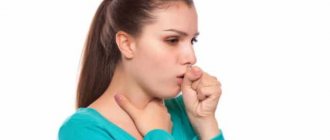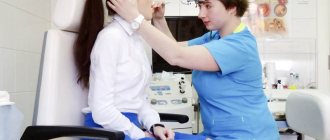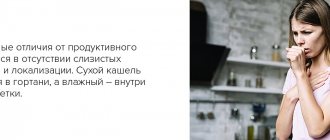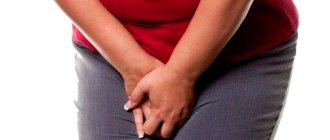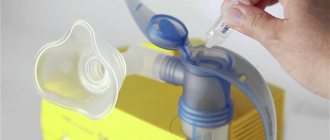Rating: 5 / 5
It is advisable to use a nebulizer for a wet cough only if it is difficult to remove mucus from the lower respiratory organs. The device delivers medicine to pathological places and stimulates the outflow of mucus. Experienced specialists prescribe inhalation for wet cough with a nebulizer in case of airway obstruction. If this is ordinary bronchitis with normal sputum production and elimination, you should not use an inhaler. In this case, the procedures slow down recovery and lead to complications.
Is it possible to use inhalations for a wet cough?
Many experts recommend a nebulizer at the first sign of illness. However, you shouldn't do this. Coughing is a normal response of the body to foreign microorganisms. If there is no sputum, the patient suffers from attacks of respiratory failure. That is, there must be discharge. If during cough syndrome the mucus is well expectorated and eliminated, there is no need to do inhalations to thin the sputum. In this case, syrups, mixtures, tablets and massage are much more effective. The pathological process does not affect the lower respiratory tract, so conventional medications help well.
Inhalation procedures with a nebulizer to remove mucus from the bronchi are prescribed in case of inflammation of the lower respiratory organs. The effect of conventional drugs is not enough, since they are maximally absorbed in the digestive tract; only a minimal part of the active substances reaches the bronchi and lungs.
Recurrent bronchitis in a child
However, in some cases, bronchitis in a child becomes recurrent. In such cases, the outpatient tactics of pediatricians, unfortunately, often come down to monthly prescription of antibiotics. I have met parents of children who were given the idea by a certain doctor that their child could not get better without antibiotics. They laughed at the word inhalation and demanded from me another antibiotic for their child, like a dose for a drug addict.
This sad case should alert you if you see that the doctor prefers what he thinks is the easiest way to treat bronchitis in your child, especially if this is not the first bronchitis. In this case, you may need to consult an allergist-immunologist, who will have to collect a very thorough medical history, that is, study the life history of not only the child himself, but also his parents, as well as grandparents at a minimum. Next, it may be necessary to conduct a special allergological examination, since recurrent bronchitis is nothing more than a harbinger of bronchial asthma - already a chronic disease of the bronchi. Let me warn you right away that in a small child we are not always able to carry out the full range of necessary diagnostic procedures, so sometimes the establishment of a final diagnosis is postponed by an allergist-immunologist until an older age, but the doctor can still prescribe preventive anti-relapse treatment, which should help both times to avoid such a diagnosis in the future. In general, based on clinical practice, I can say that even in a child under three years of age, the presence of more than two episodes of obstructive bronchitis is already a reason to consult an allergist-immunologist.
Inhalations for wet coughs in children
The child gets sick more often due to weak immunity. In this case, very often a common cold develops into a complex form of bronchitis. The disease is accompanied by the accumulation of mucus in the lower respiratory tract and difficulty in sputum discharge. The most effective treatment is inhalation through a nebulizer. Experts prescribe complex therapy, during which the active substances of medications are delivered directly to pathological areas. Inhalations to remove sputum are done after confirming the diagnosis. The duration of treatment is 3-7 days, depending on the complexity of the disease.
What inhalations do doctors prescribe for children for a wet cough?
- With mucolytic agents. Medicines dilute mucus, stimulate and facilitate its removal. Most often, children are prescribed Mucolvan, Lazolvan, Ambroxol.
- With anti-inflammatory medications. Glucocorticosteroid-based drugs are often prescribed. They effectively eliminate swelling, stop inflammation, and stimulate recovery. They have a weak expectorant effect. Breathing procedures are done with Pulmicort, Budesonide. In rare cases, antibiotics are prescribed by inhalation. They are usually prescribed to children in the form of oral syrups and tablets.
- With saline solution. Medicines are diluted in certain proportions and also used in pure form for inhalation. The product thins mucus, relieves irritation, and facilitates the removal of mucus. The procedures are done between the main inhalations, as well as after completion of the main course of treatment to consolidate the result.
Video
Inhalations for wet coughs at home for children through a nebulizer are done for 5 minutes. You should not eat or drink 1 hour before and after the procedure. The last inhalation measures are carried out 2 hours before bedtime. The duration of treatment is controlled by a pediatrician.
Inhalations for wet coughs are not given to children with normal mucus discharge. In this condition, syrups, tablets, and mixtures will have more effect. You should not treat a runny nose with a nebulizer . The first symptoms of a cold are relieved by a steam inhaler. This device is intended for the treatment of diseases of the upper respiratory tract.
Inhalations for wet cough in adults
The main indication for inhalation therapy is the presence of mucus in the bronchi and lungs, and difficulty in clearing it. A nebulizer should not be used without airway obstruction. Treatment begins after confirmation of the diagnosis and consultation with a specialist. An inhaler is not needed for a wet cough if the mucus is coughed up well.
For complex bronchitis and pneumonia, doctors prescribe medications with:
- anti-inflammatory;
- mucolytic;
- decongestant;
- bronchodilator property.
Additionally, inhalations may be prescribed for coughs with sputum with an immunostimulating effect. The breathing procedure lasts 5-10 minutes. The course of treatment is 3-10 days.
The use of inhalations for children - when to do it, process technology, features of the procedure
Treating colds in children is a troublesome task, but if you use not only modern medications, but also well-known, proven methods, you can significantly simplify this process.
The use of inhalations for children during colds has always been considered justified - both traditional medicine and official scientists approve of such procedures, and such unanimity is rare. Parents must understand that inhalation is a medical procedure, so it must be carried out in compliance with certain rules.
What to do with inhalation for a wet cough
If the diagnosis is confirmed, the patient needs inhalation treatment, the following drugs are prescribed.
Mucolytics
The choice of medicines is great. The drugs are sold in pharmacies without a prescription. Price from 50 rub. Mucolytics are necessarily part of the complex treatment of diseases accompanied by mucus accumulation. Medicines thin sputum, increase cough syndrome, and stimulate the removal of mucus from the body. For children and adults, experts most often prescribe:
- Mukolwan;
- Ambrobene;
- Ambroxol;
- Lazolvan;
- Pulmozyme;
- Fluimucil.
Immediately before use, the selected drug is diluted with saline solution. Up to 5 ml of the prepared solution is poured into the nebulizer bowl. Inhale the medicine for 5-10 minutes twice a day - morning, evening.
Bronchodilators
The drugs act on the smooth muscles of the bronchi and lungs, improving their functioning. Used for difficulty breathing and severe coughing attacks. Additionally, they have a mild expectorant effect. For a wet cough, the following is most often poured into a nebulizer:
- Ventolin Nebula;
- Salbutamol;
- Astalin;
- Salgim;
- Berotek;
- Berodual;
- Atrovent.
Bronchodilators do not treat, but eliminate symptoms, therefore they are used in combination with mucolytics and hormonal agents.
Anti-inflammatory drugs
Hormonal agents based on glucocorticosteroids quickly stop the inflammatory process, eliminate tissue swelling, and reduce the activity of histamines. The dosage is selected individually depending on the severity of the disease and the age of the patient. The duration of therapy is controlled by a specialist. At home, medications are used after consultation. Often prescribed:
- Pulmicort;
- Cromohexal;
- Budenit;
- Tafen Nazal.
Antibiotics also relieve inflammation. Medicines destroy pathogenic microflora and stop the pathological process. Fluimicil-Antibiotic is prescribed by inhalation.
Diagnosis of cough
Most often, cough is a symptom of respiratory diseases, the diagnosis of which is not difficult for a doctor. Based on the results of the examination, the specialist will determine the fact of ARVI.
A dry cough in a child without snot and fever requires more extensive diagnostics. A chest x-ray can help here, and if necessary, a specialist will refer you to a CT scan.
Fiberoptic bronchoscopy, or video bronchoscopy, is a method that can be of great importance in identifying complex and hidden causes of cough. It allows you to visually assess the patency of the bronchi, the condition of the mucous membranes, and also obtain tissue and sputum samples for further study in the laboratory.
Spirography is a method for studying the functioning of the respiratory system. It helps to assess the function of external respiration and get an idea of how fully the respiratory system works. Blood gas testing is necessary to diagnose respiratory failure.
Radiopulmonography is used to detect uneven ventilation, which is caused by narrowing of the small bronchi.
An ECG is needed to assess the function of the cardiovascular system, since sometimes heart disease is the cause of a dry cough in a child . Also, with pulmonary hypertension accompanied by a cough, there is a risk of developing heart complications.
Laboratory tests are carried out without fail. A general blood test helps the doctor draw conclusions about the activity of the inflammatory process. Since with a dry cough it is impossible to collect sputum for analysis, examination of the contents of the bronchi can only be carried out after bronchoscopy.
Procedures you can do without
Very often, after visiting a doctor, patients go to the pharmacy with a huge list of medications. Of these, half are auxiliary products with questionable effectiveness. In addition, folk remedies are often prescribed to combat wet coughs, which is unacceptable for severe diseases of the lower respiratory tract.
What you can do without:
- Mineral water Borjomi, Esentuki, Narzan. The direct purpose of the drinks is to restore the acid-base balance in the gastrointestinal tract. Used for the treatment and prevention of diseases of the digestive system. None of the packaging indicates that you can use water through a nebulizer. The patient carries out treatment in this way at his own peril and risk. Mineral water can be poured into a steam inhaler; it is used to moisturize the mucous membrane of the upper respiratory tract.
- Baking soda. Inhalations with soda during a wet cough are recommended to thin the mucus and facilitate its removal. The solution is prepared using boiled water. When using a nebulizer, such a medicine is unacceptable, since all ingredients must be sterile. It is recommended to use exclusively saline solution as a solvent. If a self-prepared medication turns out to be unsterile, pathogenic microorganisms enter the lower respiratory tract. Inflammation begins and painful symptoms intensify.
- Immunostimulants. Drugs administered by inhalation have questionable effectiveness. It is impossible to check whether the prescribed medicine is working. Recovery occurs with the help of basic medications. Inhalation procedures with immunostimulants are unnecessary. You need to increase the body's protective functions with the help of vitamins, proper nutrition, and fresh air. The most interesting thing is that immunostimulants cost a lot of money and are classified as homeopathic medicines. The most commonly prescribed drugs are Interferon and Sinupret.
Do not pour solutions based on medicinal herbs into the nebulizer bowl.
Price policy
Domestic drugs tend to be cheaper. The action is identical. But patients note the presence of side effects, so many still choose expensive drugs from imported manufacturers.
| A drug | Minimum price in rubles |
| Mukolwan | 149 |
| Ambrobene | 123 |
| Ambroxol | 288 |
| Lazolvan | 161 |
| Pulmozyme | 1480 |
| Fluimucil | 119 |
| Ventolin Nebula | 276 |
| Salbutamol | 50 |
| Astalin | 138 |
| Salgim | 1284 |
| Berotek | 98 |
| Berodual | 240 |
| Atrovent | 230 |
| Pulmicort | 398 |
| Cromohexal | 163 |
| Budenit | 707 |
| Tafen Nazal | 318 |
The issue of replacing one drug with another should be discussed with a specialist. The shelf life of medicines is 2-3 years from the date of manufacture, the prepared solution is from 30 minutes to 8 hours.
You need to breathe through a nebulizer if syrups, tablets, and mixtures do not give the desired result.
